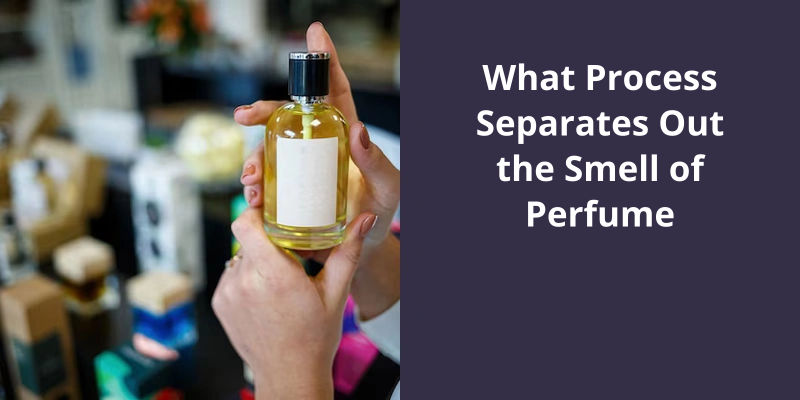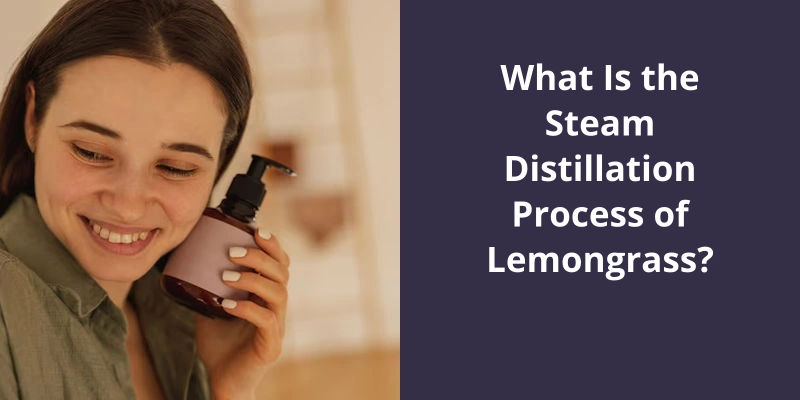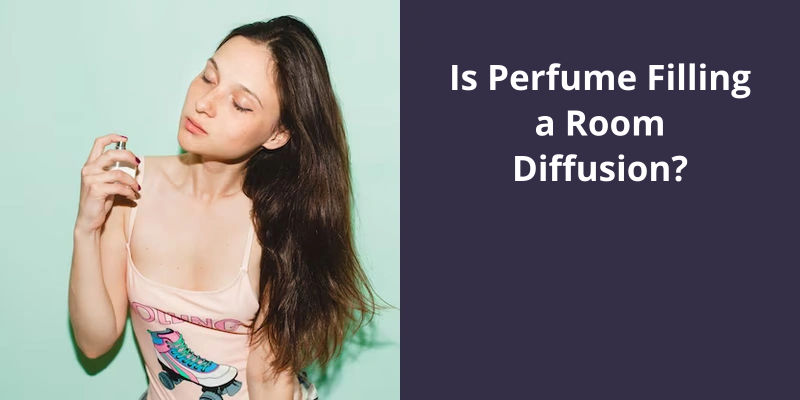The process that separates out the smell of perfume is known as diffusion. It’s a natural occurrence where molecules move from an area of high concentration to an area of low concentration. In the case of perfume, when you spray it, perfume particles spread out from the area where it was sprayed, which is a high concentration area. These particles then move into the surrounding air, which is an area of low concentration. As the perfume particles diffuse through the air, they reach our noses and that’s how we’re able to smell the perfume.

What Is the Process in Which the Fragrance of Perfume Spreads?
The process of perfume spreading is based on a scientific phenomenon called diffusion. This phenomenon is well studied and understood by scientists and researchers. Diffusion is the natural tendency of particles to move from areas of high concentration to areas of low concentration. In the case of perfume, the particles are free to move faster in all directions because of diffusion. The movement of these particles leads to a spread of the fragrance in the room.
The fragrance of perfume isn’t only pleasing to the human nose, but it also has important chemical properties that make it an effective tool for attracting others. In the case of animals, certain species use fragrances to attract mates during mating season. Similarly, plants use fragrances to attract pollinators to their flowers, which will help in the reproduction process. In essence, fragrance plays an important role in the natural world and has evolved over time to serve specific purposes.
The chemistry of perfume is complex and involves a wide range of organic compounds. These organic compounds are carefully selected and blended together to create a fragrance that’s unique and appealing. The choice of organic compounds will depend on the specific fragrance profile desired for the perfume. Some common organic compounds used in the production of perfumes include terpenes, aldehydes, esters, and ketones.
The spread of fragrance in a room depends on several factors, including the temperature, humidity, and air flow. Air flow is also important because it helps to circulate the particles of perfume throughout the room, leading to a more even spread.
The Role of Fragrance in Aromatherapy and Natural Remedies
- Eucalyptus – known for it’s respiratory benefits and refreshing scent
- Lavender – has a calming effect and is often used for relaxation and stress relief
- Peppermint – known for it’s invigorating and energizing properties and often used for headaches and nausea
- Rose – has a sweet and floral scent and is often used for relaxation and mood enhancement
- Sandalwood – has a woodsy and grounding scent and is often used for meditation and relaxation
- Tea Tree – has antibacterial and antiviral properties and is often used for skin care and cleaning products
Understanding how our sense of smell works is crucial to understanding the science of perfume. Fragrances contain volatile chemical components that are detected by the olfactory system through a process that involves attaching to cilia receptors in the nasal cavity. In this article, we will delve into the fascinating world of scent perception, the key components of perfume, and how it all comes together to create the fragrances we know and love.
What Is the Science of Perfume Smell?
These olfactory receptors are specific to certain odor chemicals and are highly complex, capable of detecting even the slightest variations in molecular structure. Once activated, the receptors send signals to the brains olfactory cortex, where perception of the odor occurs.
Perfumers use a variety of natural and synthetic fragrance compounds to create unique scents. These synthetic molecules are typically created in a lab using a variety of chemical reactions to form complex aromatic compounds.
One of the most important aspects of fragrance chemistry is the head, heart, and base structure, where the scent is divided into three parts. The top or head notes are the initial burst of scent that are typically lighter and more volatile. The middle or heart notes are the core of the fragrance that last longer than the top notes. Finally, the base notes are the longest-lasting, most stable component of the fragrance.
Another key factor in fragrance chemistry is the concept of odor intensity. A scents intensity or strength is determined by the concentration of the fragrant molecules in the air. The intensity of a fragrance can be increased or decreased as desired by adjusting the concentration of the fragrance compounds in the final product.
Overall, the creation of a perfume is a delicate balance of art and science. Ultimately, the ability to create a memorable and captivating fragrance is a true testament to the mastery of the science of perfume smell.
Source: Influence of Fragrances on Human Psychophysiological Activity
As we know, the way smells move is through diffusion, with odor particles dispersing throughout the air. This is a basic yet fascinating process that drives our sense of smell. However, the power of diffusion isn’t always limited to just one scent. Sometimes it goes beyond that, encompassing an entire space with different smells. So, what do we call this phenomenon? Let’s delve deeper.
What Is It Called When a Smell Spreads?
When a smell spreads, it means that the odour particles are moving from an area of high concentration to an area of lower concentration. This process is driven by a potential energy gradient, with the concentration of odour molecules decreasing over time until it reaches equilibrium. This can be seen when a person sprays perfume into a room, and the smell gradually spreads throughout the space.
The rate at which a smell spreads depends on a number of factors, including the temperature and humidity of the air. In general, odours diffuse more rapidly in warmer, more humid air than in cooler, drier air. The size and shape of the room also play a role, as odours tend to accumulate in corners and other enclosed spaces where air flow is restricted.
One of the most interesting aspects of the spread of smells is the way in which they can affect our emotions and behavior. Certain smells, like the aroma of freshly baked bread, can trigger feelings of comfort and nostalgia, while others, like the stench of rotting garbage, can make us feel nauseous and repulsed. This is because smells are closely linked to our memories and emotions, and can elicit powerful responses in our bodies and minds.
The process of diffusion also has important implications for our health and well-being. Smells can carry harmful chemical pollutants, and exposure to high concentrations of these odours can cause a range of health problems, including respiratory issues, headaches, and nausea. As such, it’s important to be mindful of the sources of odours in our environment and take steps to mitigate our exposure to them.
The spread of smells is a fascinating process that’s driven by the movement of air particles and odour molecules. This process has important implications for our emotions, behavior, and health, and understanding how it works can help us to create more pleasant and healthy environments. As we continue to explore the mysteries of the sense of smell, we’re sure to uncover even more fascinating insights into the world of scent.
As we delve deeper into the world of smells, one question often arises – does smell flow up or down? While it may seem like a simple query, the answer isn’t as straightforward as you might think. Smells travel through the air in a complex way, through a process called diffusion, where air particles and odour particles within the air move freely in all directions. In this article, we’ll explore the various factors that play a role in determining the flow of smells, and whether they’re more likely to go up or down.
Does Smell Flow Up or Down?
However, it isn’t accurate to say that smells flow up or down. The movement of smells is determined by a number of factors, such as air temperature, humidity, and air circulation. In a still or stagnant environment, smells can linger in one spot. This is often the case in small enclosed spaces without ventilation, like an elevator.
In an open environment with constantly moving air, such as outdoors on a windy day, smells can travel for great distances in all directions, depending on the strength of the scent and the wind speed. For example, the smell of a barbecue could travel a few blocks away from the source on a breezy day.
It’s also important to note that different types of smells have different densities and weights. Heavy smells, such as smoke or fumes, can be affected by gravity and sink downward. This is why many ventilation systems are designed with exhaust fans near the ceiling and intake vents near the floor to help remove heavier contaminants from the air.
On the other hand, lighter smells, like perfume or fresh flowers, tend to remain in the air and can float in all directions. This is why perfumes are often sprayed into the air rather than directly onto the skin to ensure spread.
The movement of smells isn’t necessarily determined by directional flow.
Understanding the science behind how smells are made and how they travel is an essential part of unlocking the mystery of our olfactory senses. By examining the invisible particles that make up a smell and exploring the factors that influence their strength and potency, we can gain a deeper appreciation for the art of scent and the role it plays in our perception of the world around us.
Do Smells Contain Particles?
Yes, smells do contain particles, and these particles can vary in size and composition depending on the substance that’s producing the odor. These particles can be as small as individual atoms or molecules, or they can be larger particles that are made up of multiple atoms and molecules. When we smell something, we’re essentially detecting these particles as they enter our nose and interact with receptors in the lining of our nasal passages.
The process of creating a smell is called evaporation, and it occurs when a substance changes from a liquid or solid to a gas. This can happen naturally, such as when a flower releases it’s scent into the air, or it can be artificially induced through processes like heating, cooking, or burning. Some substances are more volatile than others, meaning they evaporate more easily and release more particles into the air. This is why some smells are stronger than others, even when the substances themselves are present in similar amounts.
Once a substance is evaporated and it’s particles are released into the air, they can be carried by air currents and spread throughout a space. The particles can also interact with other particles in the air, such as oxygen or other chemicals, which can change the smell and composition of the odor. This is why smells can sometimes change or become less potent over time or in different environments.
These receptors are located in the olfactory epithelium, a specialized tissue that lines the inside of our nasal cavity. This process is highly sensitive and can detect even very small amounts of odor particles in the air.
Conclusion
In conclusion, the process that describes the smell of perfume separating out is diffusion. It’s a natural phenomenon that occurs due to the tendency of gas molecules to spread out and occupy the available volume. This fundamental concept of diffusion has vast implications in various fields of science and technology, including chemical engineering, atmospheric science, and biophysics. Understanding the dynamics of diffusion can lead to breakthroughs in a range of applications, from designing more efficient perfumes to predicting the behavior of pollutants in the environment.





